Is The Rings of Power drawing inspiration from Tolkien’s incomplete Fourth Age work, The New Shadow?
Upfront: I’m a big believer in Betteridge’s law of headlines. This maxim states that: any headline that ends in a question mark can be answered by the word “no”. There’s every chance that “no” is the right answer to this lede.
Yet, the idea that Rings of Power — in its use of cults — could be cribbing ideas from Tolkien’s fragmentary Fourth Age story remains an alluring one that my mind keeps circling back to.
In part, it’s because of the creepy and unsettling power of that exchange between the as-yet-unidentified wild-eyed fellow and Theo in the trailer: “Have you heard of him, boy? Have you heard of Sauron?”
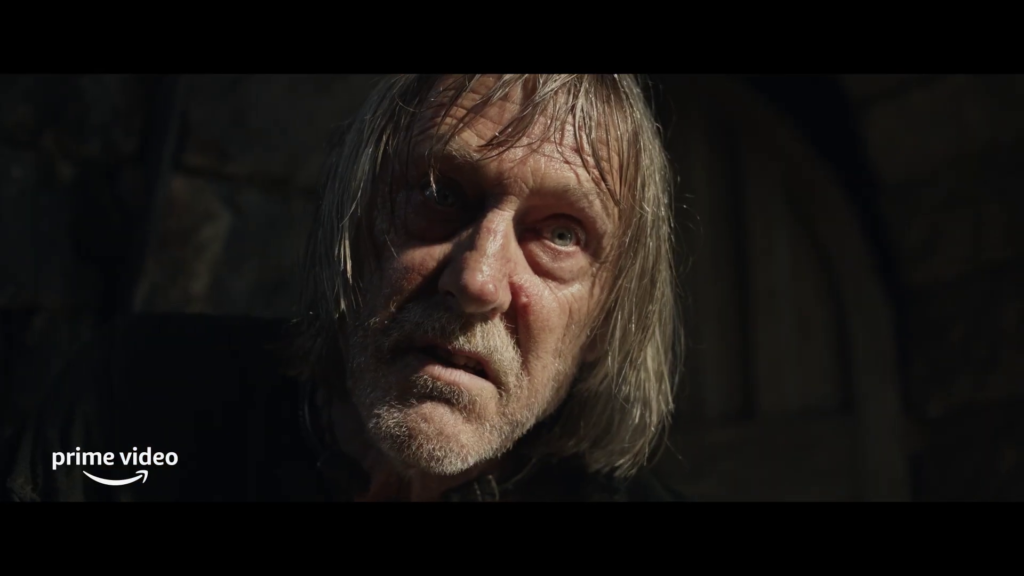
What is The New Shadow?
The New Shadow is found in the final volume of The History of Middle-earth amongst a number of essays that Chris Tolkien classified as “Late Writings”. It’s actually quite slim, totalling only 13 pages in my edition — including CJRT’s page-and-a-half introduction and footnotes.
Much of it is a slow-moving philosophical meditation as the two characters — the aging but steadfast Borlas, and the youthful, but seemingly embittered and restless, Saelon — trade barbs about the “roots of Evil”.
Then, in the final few pages this key exchange occurs:
‘You have heard then the name?’ With hardly more than breath he formed it. ‘Of Herumor?’
Borlas looked at him with amazement and fear. His mouth made tremulous motions of speech, but no sound came from it.
‘I see that you have,’ said Saelon. ‘And you seem astonished to learn that I have heard it also. But you are not more astonished than I was to see that this name has reached you. For, as I say, I have keen eyes and ears, but yours are now dim even for daily use, and the matter has been kept as secret as cunning could contrive.’
The New Shadow, The Peoples of Middle-earth
Perhaps it’s mere coincidence. Yet the similarity to the dialogue from the teaser with what Tolkien wrote is startling. There’s also a strong parallel in the visual reaction of Theo and the written one of Borlas: surprise, trepidation, fear.
Who is recruiting whom?
Is Saelon recruiting to a dark cause? Is the wild-eyed crazy fellow in the trailer doing likewise?
While we shall eventually find out the answer to the latter, we’ll never know the answer to the first question for certain.
Saelon certainly seems fishy — and his later invitation to Borlas to attend a shady, night-time rendezvous to learn more about the mysterious Herumor contains the scent of deceit.
But Tolkien never continued the story.
Within his reasons for abandoning the tale are some illuminating nuggets — nuggets that are, I think, relevant to the reasons for Númenor’s ultimate fall, and what Rings of Power may be trying to achieve with its own Sauron cult(s).
Since we are dealing with Men it is inevitable that we should be concerned with the most regrettable feature of their nature: their quick satiety with good. So that the people of Gondor in times of peace, justice and prosperity, would become discontented and restless…
[and]
I found that even so early [after the death of Aragorn] there was an outcrop of revolutionary plots, about a centre of secret Satanistic religion; while Gondorian boys were playing at being Orcs and going round doing damage.
Letter #256, Letters of J.R.R. Tolkien
Discontented and restless: when enough is still not enough
This is the very essence of the Akallabêth tale.
The Dúnedain of Númenor want for nothing, and live long lives in peace and prosperity, yet it’s not enough. They grow increasingly unsatisfied with all that they already have. Then, by gradual steps, they “fall”: transforming from helpers in Middle-earth to colonial conquerors and ultimately embarking on a doomed rebellion against the powers of Valinor in a vain quest for immortality.
Sauron’s presence merely hastens a process that was already occurring. Remember that the White Tree in Armenelos — a metaphor for the spiritual well-being of Númenor — was already in decline during the reign of Ar-Pharazôn’s grandfather.
Restless folk “playing at orcs”
One wonders if that’s exactly what we’re looking at with the trio of dissatisfied-looking folk in white robes in the trailer: “discontented and restless” folk “playing at being Orcs”. Or as Tolkien further outlines in Letter #338: “owing to the (it seems) inevitable boredom of Men with the good: there would be secret societies practising dark cults, and ‘orc-cults’ among adolescents.”
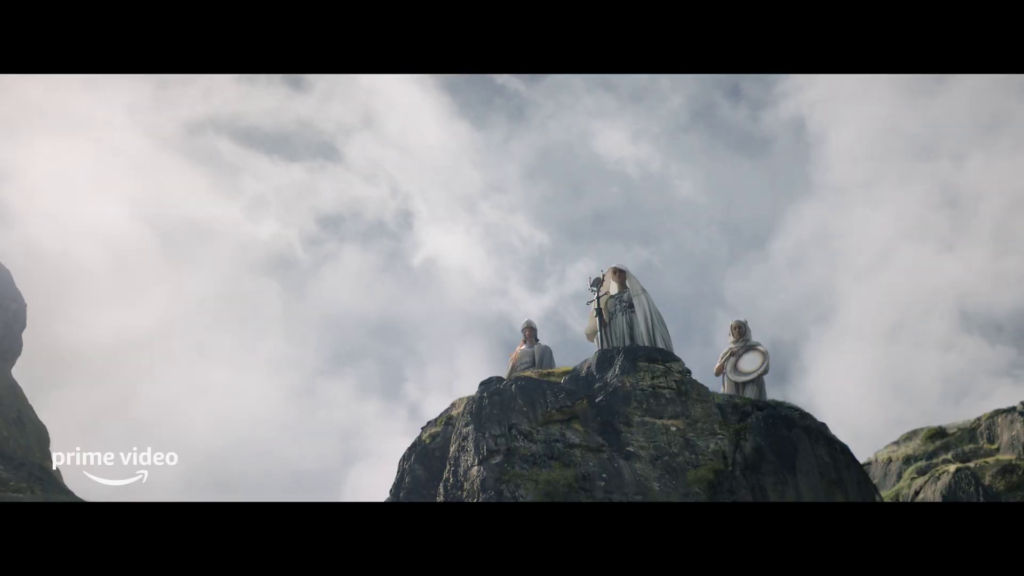
If it looks like a cult…
Can we even be sure these people are part of a cult?
First there’s the implication from the dialogue that, more or less, accompanies those frames: “Evil does not sleep. It waits.”
Consider how that parallels the thrust of the very opening of The New Shadow:
‘Deep indeed run the roots of Evil,’ said Borlas, ‘and the black sap is strong in them. That tree will never be slain. Let men hew it as often as they may, it will thrust up shoots again as soon as they turn aside. Not even at the Feast of Felling should the axe be hung up on the wall!’
The New Shadow, The Peoples of Middle-earth
At a surface level, visual tropes further reinforce that assessment.
- Hooded robes. Because every cult needs robes.
- The staff and mirror. Every cult also needs its own hermetic symbology and gear.
- Scene composition. This suggests both insularity (and groupthink), and an unobserved surveillance of events (ie: panopticon-style powers).
None of these is individually conclusive; together, they are highly suggestive.
Yet there are aspects that depart from the stereotypical visuals that we might expect from a Sauron cult.
Visual oddities: white robes
In particular, Sauron’s minions never use white. In the Lord of the Rings, the Eye is always said to be red. The hand is referred to as the black hand.
‘S is for Sauron,’ said Gimli. ‘That is easy to read.’
‘Sauron does not use the Elf-runes.’
‘Neither does he use his right name, nor permit it to be spelt or spoken,’ said Aragorn. ‘And he does not use white. The Orcs in the service of Barad-dûr use the sign of the Red Eye.’
The Departure of Boromir, the Lord of the Rings
And:
He [Mouth of Sauron] it was that now rode out, and with him came only a small company of black-harnessed soldiery, and a single banner, black but bearing on it in red the Evil Eye [my emphasis].
The Black Gate Opens, The Lord of the Rings
And, in The New Shadow, Saelon suggests that Borlas should wear black robes when he extends an invitation to join one of Herumor’s secret meetings.
One might argue that these are all post-Akallabêth developments — after Sauron loses any ability to assume a fair-hue. In fact, Unfinished Tales describes how in Lindon “Gil-galad shut out Sauron’s emissaries and even Sauron himself”, indicating that Sauron used others to further his long deception of being an emissary of the Valar sent to aid the elves.
Those others would have to appear just as innocent as their master regardless of who they were approaching.
Still, white-robed cultists are a visual contradiction to our textual knowledge. Depending on your attitude to the production, that’s either puzzling or concerning.
Visual oddities: the sigil on the staff
The second conundrum is the design of the staff of the apparent leader of our trio of cultists. This design seems to employ the symbolism of an eye.
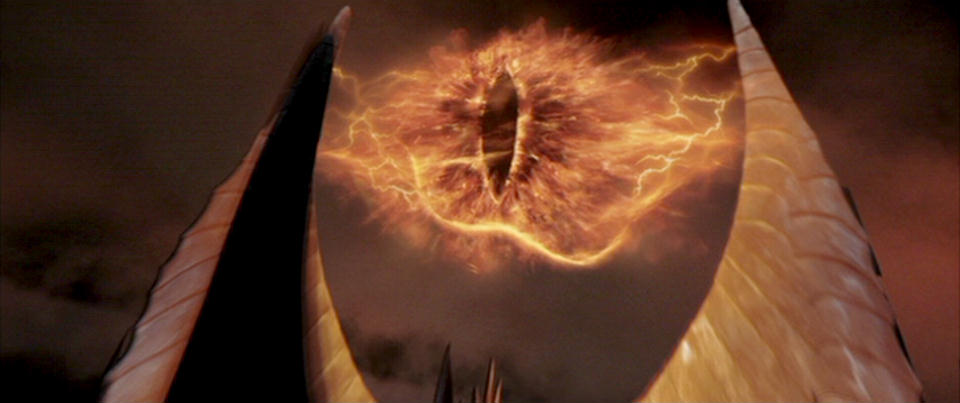
Parallels with Peter Jackson’s “The Eye of Sauron” atop the two spires of Barad-dûr are obvious.
Why is this a problem?
Well, the Rings of Power production already seems to have settled on a different symbol for Sauron — the Númenorean rune (not an elf rune) that Galadriel finds embedded into an anvil in the Forodwaith.
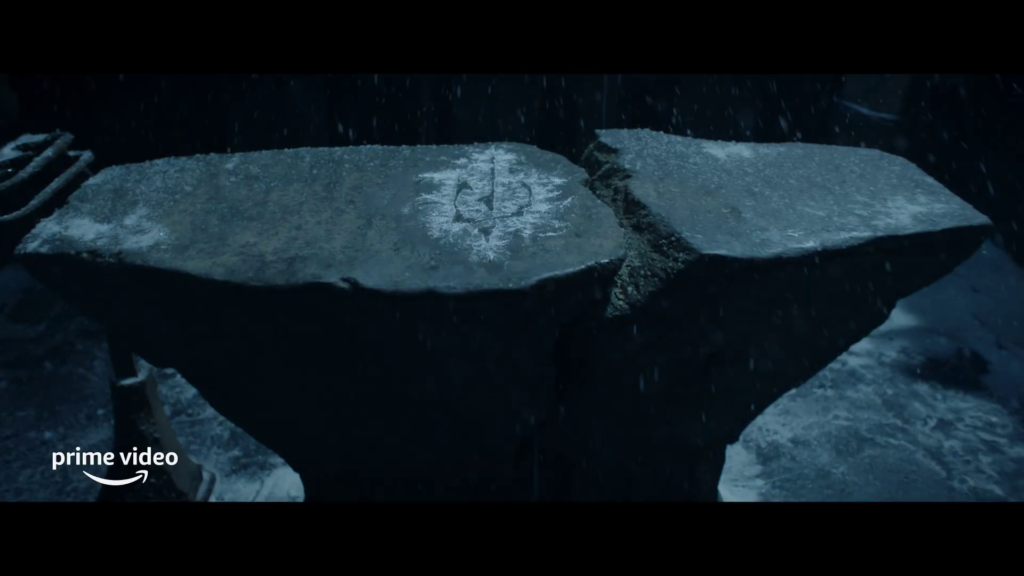
One could refer back to Aragorn’s statement that “neither does he use his right name, nor permit it to be spelt or spoken”. But that’s trying to have it both ways: the rune barred to his minions, but white being okay.
Right now, I can’t readily reconcile this.
Cults and “magics” in Middle-earth
Still, between our wild-eyed fellow and Theo and the various appearances of white-robed and hooded individuals, the SDCC trailer feels determined to suggest a dangerous cult with nefarious purposes and uncanny powers.
A glance through the Legendarium reveals fertile ground for cults in Middle-earth.
The very beginning of Akallabêth states:
Men came into the world in the time of the Shadow of Morgoth, and they fell swiftly under his dominion; for he sent his emissaries among them, and they listened to his evil and cunning words, and they worshipped the Darkness and yet feared it.
Akallabêth, the Silmarillion
In The Lord of the Rings, Aragorn tells how the folk of Erech refused the summons of Isildur because they had “worshipped Sauron in the Dark Years”.
And, in outlining the origins of the Mouth of Sauron, The Lord of the Rings tells us of Black Númenoreans who “established their dwellings in Middle-earth during the years of Sauron’s domination, and they worshipped him, being enamoured of evil knowledge.”
A Rings of Power cult need not even be inspired by Sauron. In a 1958 letter Tolkien wrote of the Blue Wizards, guessing that they “were founders or beginners of secret cults and ‘magic’ traditions [my emphasis] that outlasted the fall of Sauron.” Something similar could explain the white robes — although such an explanation raises equivalent problems with the “cult leader’s” staff.
Plus, some of those followers are practitioners of dark art.
Mouth of Sauron is said to have learned “great sorcery” as he gained favour. Gandalf describes the Witch King of Angmar as a “great king and sorcerer… of old”, while The Peoples of Middle-Earth briefly describes not only that Sauron enslaved the spirits of some elves to his will, but that he taught the same necromancies to his followers.
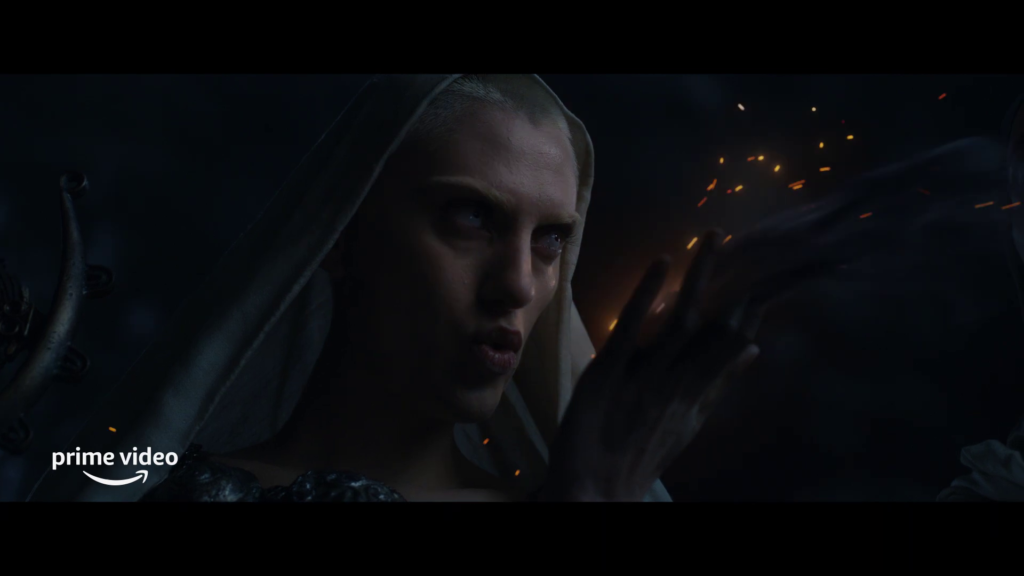
Now, this might not seem much like necromancy, but also recall that Sauron’s nature is one of fire and that, until he was seduced by Morgoth, he was a student and follower of Aule.
A final parallel with The New shadow
Returning to The New Shadow, there’s one final — if slight — parallel with Rings of Power. In one of the recent interviews at San Diego Comic-con, Tyroe Muhafidin observes about his character:
“We find Theo — he’s not the most happy-going guy; he’s not living in the greatest circumstances. He’s living in what you could call the slums. So he’s a bit angsty towards the world.
He finds something in the bottom of a barn, and there’s lot of secrets to it – and he’s dying to find out [them].”
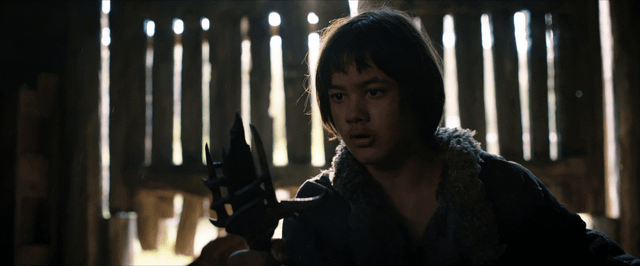
Now, that’s not a life of prosperity. Theo is not driven by “boredom of Men with the good”.
But it does sound as though there’s a chip on Theo’s shoulder — and that’s something that is characteristic of Tolkien’s Saelon — embittered as he remains over being accused by Borlas of “Orcs’ work” after stealing fruit as a young child.
That may prove fertile ground for the creepy old guy in the trailer. Theo might not have previously been attracted, as Tolkien describes it in The New Shadow, to “tales of the Orcs and their doings”.
“I had not been interested till then. You turned my mind to them.”
BOOTNOTE
There is one other comparison with these cultists that I simply cannot overlook. But it’s not a Tolkien-based one — it’s one with Mervyn Peake, the famed author of the gothic masterwork, Gormenghast.
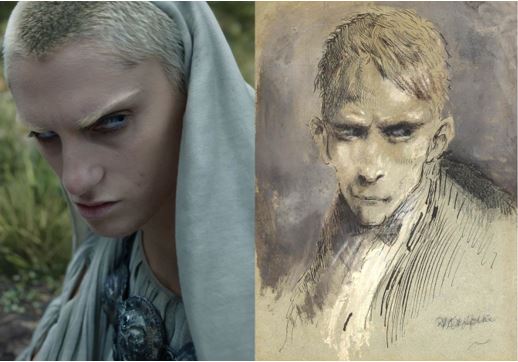
Peake was also an impressively talented sketch artist, and a friend pointed out that one of Peake’s sketches of his arch-villain Steerpike bears an uncanny resemblance to a certain cultist. Now, having seen it, I can’t get it out of my head.
Acknowledgements: Many thanks to all the Discord Reading Room mods for their feedback on this piece and especially DrNosy for the structural critique. GIF courtesy of the ever-talented WheatBix.
About the author: Staffer Demosthenes has been involved with TheOneRing.net since 2001, serving first as an Associate News Editor, then as Chief News Editor during the making of the Hobbit films. Now he focuses on features and analysis. The opinions in this article are his own and do not necessarily represent those of TheOneRing.net and other staff.


